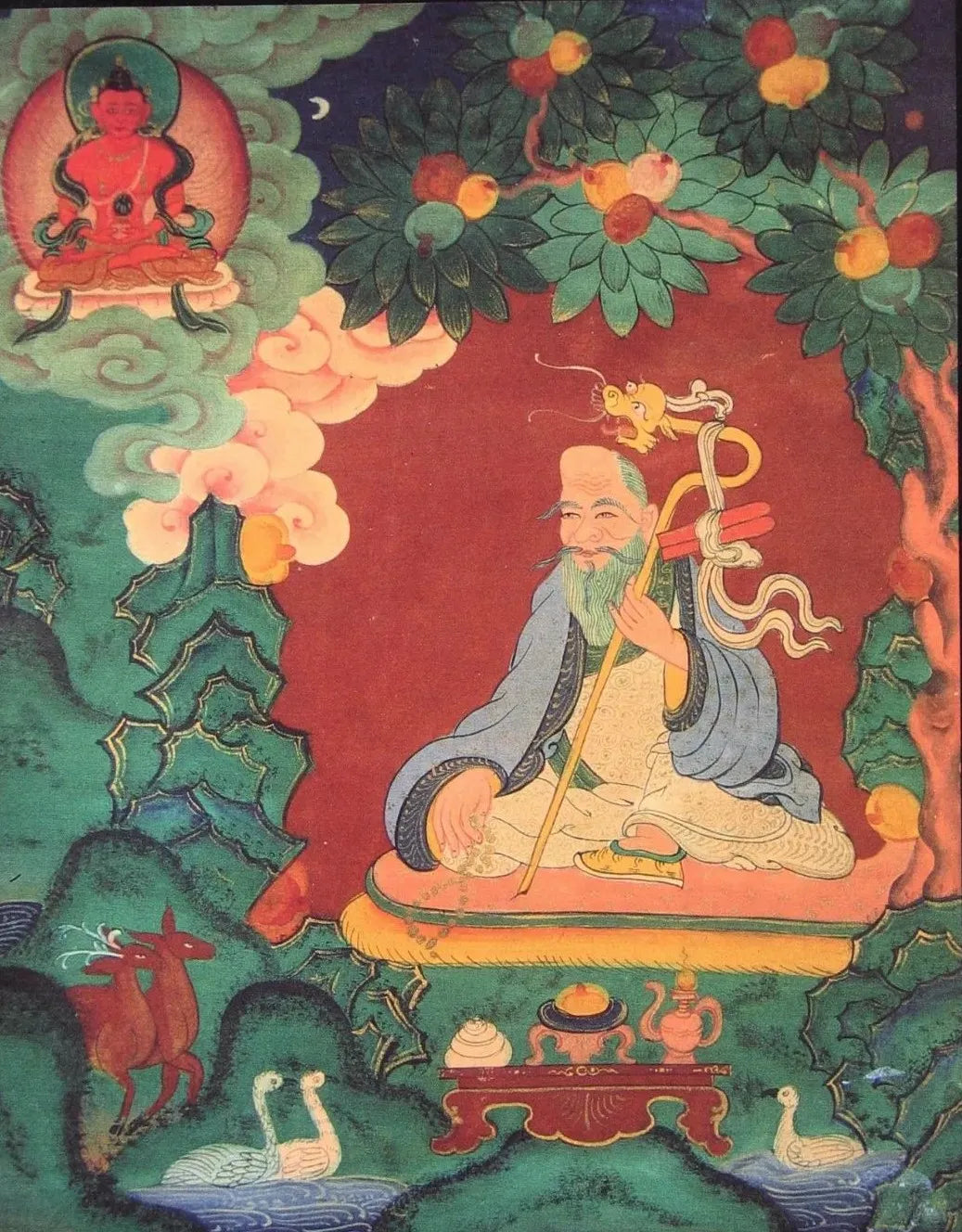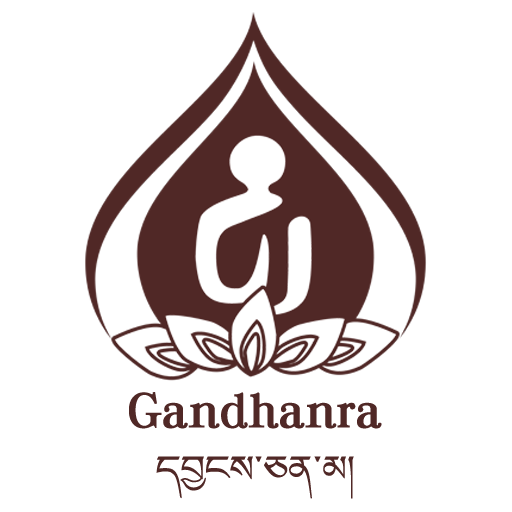
Do traditional Tibetans celebrate birthdays? | Tibetan Birth Ceremonies

"The Six Longevity Panels", 18th century
Collected by Robert and Lois Baylls

"The Six Longevity Panels", 19th century
Buryat History Museum
Life and Death
Today, regardless of age, Tibetan people also eat cakes and blow candles to celebrate their birthday. However, traditionally Tibetan people do not emphasize birthdays as much, as Tibetan culture seems to focus more on observing and contemplating death. But this does not mean that there is a lack of birth ceremonies in Tibetan culture - in the past, a fortunate Tibetan person would experience four important ceremonies in their lifetime: the birth ceremony, the hair cutting ceremony, the wedding ceremony, and the eightieth birthday celebration. Obviously, three of them are related to "birth".

The Old Man of Tibet. Image source: Pinterest
Secondly, due to the development of traditional astrology, Tibetan people value the correspondence between zodiac signs and constellations more than just birth dates, and they relate this to daily activities. For example, people believe that things will go more smoothly on their soul day (བླ་གཟའ) and longevity day (སྲོག་གཟའ), while they try to do more good deeds on inauspicious days (གཤེད་གཟའ) to avoid bad luck. These three days vary according to each person's zodiac sign, for example, for those born in the year of the rat, their soul day is Wednesday, their longevity day is Tuesday, and their inauspicious day is Saturday.

The cyclic diagram of form and elements in the "Abhidharmakosha" depicts a clear and empty sky at the bottom, with the initial appearance of the wind wheel. Above it is a solid golden cloud, forming the water wheel. The movement of the wind on the water wheel creates a golden foundation. In the center of the foundation is Mount Sumeru, surrounded by seven layers of golden mountains, a great ocean of milk, the four continents, and smaller islands. From a Buddhist perspective, the world of Samsara will ultimately be destroyed by earth, water, fire, and wind.
Birth
If we must say how traditional Tibetan people celebrate birthdays, a simple record from the historical document "Bal Shyak" about the birth of Prince Chagsam Deutsen may serve as a representative case. The book records: "After the prince was born, the king was very happy and immediately ordered the construction of 108 stupas overnight. He said, 'With the remaining mud, build another stupa in our likeness,' and thus another stupa decorated with nets, bells, and more was built." Although contemporary scholars have doubts about the time of composition and some content of this document, it does not hinder us from glimpsing into the way people celebrate birthdays from the perspective of Buddhist culture. Even in modern times, traditional Tibetan people still choose to celebrate various holidays through activities such as releasing animals, sponsoring, and consecrating stupas.

When we focus on the strict sense of birth, that is, when the mother gives birth, Tibetan culture also reflects the rugged and vibrant characteristics of the plateau: first, people will observe whether the newborn is healthy (and auspicious or not) based on whether it is a natural birth, whether the umbilical cord is wrapped around the neck, whether the voice is loud, and whether the sucking is strong. Then they sing and recite: "You are the child of my heart, may you live long and see all the ups and downs of the world, may you overcome all obstacles, and live a life of happiness and prosperity." (བདག་གི་བུ་ཁྱོད་སྙིང་ལས་སྐྱེས་པ་ཡིན། ། ལོ་བརྒྱ་འཚོ་ཞིང་སྟོན་བརྒྱ་མཐོང་གྱུར་ཅིག ། ཚེ་རིང་དཔལ་ཐོབ་ངན་དགུ་ཐུབ་པ་དང་། ། མི་ནོར་བཀྲ་ཤིས་བདེ་སྐྱིད་ཕུན་ཚོགས་ཤོག །).

In the first half of the 20th century, Menzikang in Lhasa.
On the third day after birth (for a boy) or the fourth day (for a girl), a celebration ceremony is held, where the first thing to do is to shave off the baby's lanugo. Then, guests bring a bag of mashed barley and fresh butter, and apply a small amount of butter and mashed barley on the baby's forehead to express wishes of good health and prosperity. In the eyes of rural Tibetan people, mashed barley is a sacred item that sustains life, so placing it on the baby's forehead is perhaps the most sincere and eternal blessing; in addition, it can also be understood as smoothing out the baby's forehead wrinkles to protect the delicate skin."

In the first half of the 20th century, Lhasa Mendikang
Details: Midwifery (སྐྱེ་བསུ་) and Doula (སྐྱེ་གཡོག་)
shaving ceremony and coming-of-age ceremony
The head-shaving ceremony, known as "མནོལ་སྟོན" in Tibetan, is a ritual where a child's hair is shaved off at the age of three by a respected elder in the community. The child's head is shaved, leaving only a small tuft of hair at the back. During the ceremony, the elder recites a prayer wishing the child success and prosperity in life.
In addition to the head-shaving ceremony, there is also a coming-of-age ritual that is typically held at the ages of fifteen, sixteen, or seventeen. There is a saying in Tibetan culture that goes, "At fifteen, a boy can make decisions without consulting his father, and at fifteen, a girl can cook without her mother's help." However, the coming-of-age ceremony for girls often involves more elaborate rituals, such as wearing traditional headpieces, braiding hair, and wearing symbolic women's attire. These ceremonies recognize a girl's transition into adulthood and signify her eligibility for marriage.

Tibetan children. Image source: Pinterest
Eighty white robes
A white woolen vest with a sun, moon, and swastika symbol on the back is one of the most auspicious clothes in Tibetan attire, as only octogenarians are eligible to wear it. This day is called "Eighty White Clothes" in Tibetan, and elderly people celebrating their longevity need to dress up in the morning with a new outfit, wear a white undershirt, tie a blue belt around their waist, put on a white felt hat, wear patterned long boots, and carry a red rope. On this day, all young people congratulate the elder on their longevity, and the elders also wish for prosperity for the youth and everything else that is auspicious(ཡ། བྱིས་པ་ཚོ་འདབ་ལག་རྒྱས་པའི་བཀྲ་ཤིས་ཤོག ། གཞོན་པ་རྣམས་ཚེ་ཐག་རིང་བའི་བཀྲ་ཤིས་ཤོག ། བཀྲ་ཤིས་ཀུན་གྱི་བཀྲ་ཤིས་ཤོག). Another traditional custom is to have the elderly recite the verses of the long-lived general Amichagan(སྤྱི་དཔོན་རོང་ཚ་ཁྲ་རྒན) from the epic "King Gesar" for good luck.

Usually, the 80th birthday celebration is held on the 3rd or 13th of each month. Although some scholars believe that this corresponds to the three young stages of "youth, young adulthood, and middle age," this may actually be related to the numerical worship in Tibetan culture. In the paper "Critical Points of Life Transitions - The Mother Theme of Number 13 and Tibetan Coming-of-Age Ceremony," the author points out the significance of the number 13 inherited from the Bon faith in various historical periods in Tibetan literature and works. In simple terms, this numerical worship is not only unique to Tibetan culture, but also has a direct relationship with the Bon faith and the primitive culture admired by the Mosuo people living near Lugu Lake on the border of Yunnan and Sichuan. The auspicious meaning behind this number is more closely related to the epic of "King Gesar."

An elderly Tibetan man wearing a white vest embroidered with patterns of the sun, moon, and Yongzhong.
In addition, writer Pema Tsayang believes that this white cloth blessing ceremony may have originated from the 1791 celebration of Emperor Qianlong's 80th birthday. That year, the emperor ordered a list of 70 to 100-year-old Tibetans to be submitted, and rewarded 192 people from the Ü-Tsang region with 732 taels of silver, as well as white long life robes. Additionally, fly-eaved and bracketed roofs were built to indicate that the elderly residents were blessed with longevity.

"The Six Longevity Panels", 19th century
The Rubin Museum of Art in New York
Life and death transformation
In the traditional culture of Tibet, life and death have always been seen as a transformational relationship. Life is not something to be grandly celebrated, and death is not just a negative event. In Tibetan culture, there is a greater focus on the art of death, which actually presents a more positive attitude. It represents a striving for the eternal life beyond the silence of death, and it is an encouragement and courage for individuals to face the suffering of all.
 The image of a long-lived old man in a monk's robe
The image of a long-lived old man in a monk's robe
Transcend the silence of death
References:
"Ba Xie"
Lin Jifu: "Critical Points of Life Turning: The Mother Theme Number 'Thirteen' and Tibetan Rite of Passage"
Tang Duoxian: "On Headwear in Tibetan Life Rites"
Jia Li: "Traditional Tibetan Marriage and Fertility Culture"

1 comment
n4tado